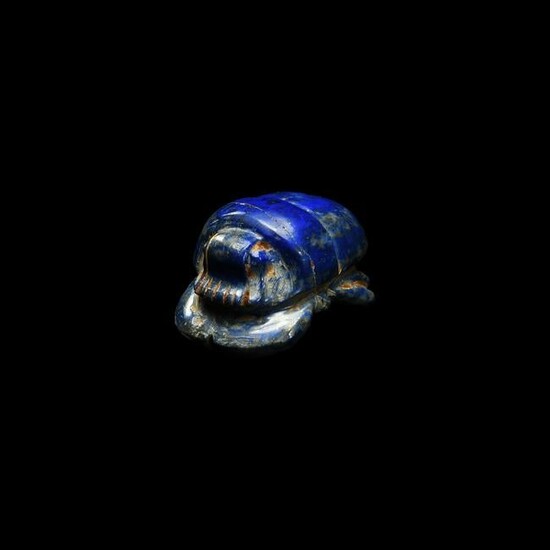Egyptian Lapis Lazuli Funerary Scarab
Late-Ptolemaic Period, 664-30 BC. A carved lapis lazuli funerary scarab with detailing to head, legs and carapace, clypeus with six lobes, large head with protruding eyes; ribbed suspension loop to inverted v-section angled base. See The Metropolitan Museum, accession number 89.2.398, for broadly similar; see The British Museum, museum number EA66522, for comparable; see also Petrie, W.M.F., Amulets, London, 1914. 17 grams, 30mm (1 1/4"). Property of a London gentleman; before that in the private collection of a Kensington collector; previously in the collection of Mrs Petra Schamelman, Breitenbach, Germany; acquired from the collection of Fernand Adda, formed in the 1920s; accompanied by an academic report by Dr Alberto Maria Pollastrini. This lapis lazuli scarab beetle is part of the panoply of amulets which followed the deceased in the journey through the Netherworld (Petrie, 1914, 24-25, pl. XI, [92], L-LIII) and could potentially have been sewn into a funerary necklace or onto the bandages of the mummy. The scarab beetle’s behaviour of rolling large dung balls was associated by the ancient Egyptians with the movement of the sun through the sky. They also thought that this beetle generated spontaneously in the ground. The belief in the scarab’s self-generation and its association with the sun god made it a potent amulet that was thought to bear the power of life and regeneration. [A video of this lot can be viewed on the Timeline Auctions website]
Condition Report: Fine condition, repaired.
View it on
Estimate
Time, Location
Auction House
Late-Ptolemaic Period, 664-30 BC. A carved lapis lazuli funerary scarab with detailing to head, legs and carapace, clypeus with six lobes, large head with protruding eyes; ribbed suspension loop to inverted v-section angled base. See The Metropolitan Museum, accession number 89.2.398, for broadly similar; see The British Museum, museum number EA66522, for comparable; see also Petrie, W.M.F., Amulets, London, 1914. 17 grams, 30mm (1 1/4"). Property of a London gentleman; before that in the private collection of a Kensington collector; previously in the collection of Mrs Petra Schamelman, Breitenbach, Germany; acquired from the collection of Fernand Adda, formed in the 1920s; accompanied by an academic report by Dr Alberto Maria Pollastrini. This lapis lazuli scarab beetle is part of the panoply of amulets which followed the deceased in the journey through the Netherworld (Petrie, 1914, 24-25, pl. XI, [92], L-LIII) and could potentially have been sewn into a funerary necklace or onto the bandages of the mummy. The scarab beetle’s behaviour of rolling large dung balls was associated by the ancient Egyptians with the movement of the sun through the sky. They also thought that this beetle generated spontaneously in the ground. The belief in the scarab’s self-generation and its association with the sun god made it a potent amulet that was thought to bear the power of life and regeneration. [A video of this lot can be viewed on the Timeline Auctions website]
Condition Report: Fine condition, repaired.



